Kiel Moe FAIA

Architect
Visiting Professor, Massachusetts Institute of Technology
2022 AIA College of Fellows inductee, AIA Vermont member
When did you first become interested in architecture as a possible career?
I left high school a semester early at age 17 to work for Denver architecture firm Anderson Mason Dale, and never looked back. They offered me an unusually generous and enthusiastic start in architecture.
Who or what deserves credit for your success?
How much room do I have for this response? My many mentors, colleagues, and clients: Ron Mason, Daniel Friedman, Jacob Mans, Salmaan Craig, Asher Woodworth, Stephen Greenblatt.
Who do you think is the most underappreciated architect and why?
It is easier to identify over-appreciated single architects. I think we underappreciate the immense collective intelligence and talent that is required to build even the most modest of buildings.
What is your favorite Boston-area building or structure?
Olmsted’s The Emerald Necklace.
Has your career taken you anywhere you didn’t expect?
I spend a lot of time right now reading about the earliest days of upright, hairless humanoids, trying to understand exactly how and why some of them start to build shelters.
Which one of your current projects excites you the most?
The Washington Avenue sauna in Portland, Maine, and a project north of Chicago in which the disassembly of a 60’x180’ wood barn will become a five-car garage, a sauna, and a live/work studio. The barn remnants also frame a new croft garden. Our task is to creatively redistribute extant materials.
What has been your most proud moment as an architect/designer?
I am often impressed by how certain students exceed me, and teach me to think in new ways, through their development of new ecological practices.

What do you see as the largest barrier to equity in your profession?
The unequal economic and ecological exchanges that presuppose building and urbanization are architecture’s largest, and least studied, sources of inequity. The iniquity of how schools of architecture are structured, and what they emphasize, is the most immediate barrier to a more socially just, and ecologically sane, future for building and urbanization.
What do you see as the largest barrier to a zero-waste building, city, and world?
None of our goals should be net-zero anything. Architecture should maximize its positive impacts on the world, not aim to do less harm.
Who do you most enjoy partnering with on a project?
Practice Landscape.
Where do you find inspiration?
Forests and students.
What are you reading right now?
Graeber, & Wengrow, D. (2021). The Dawn of Everything : A New History of Humanity (First American edition.). Farrar, Straus and Giroux.
If you could redesign anything, what would it be?
The Beaux-Arts, guild-based system of architectural education in North America. Nothing is more responsible for the systemic failures of architecture and urbanization than how schools of architecture continue to train architects.

